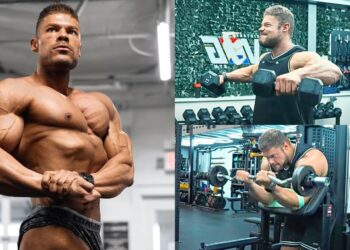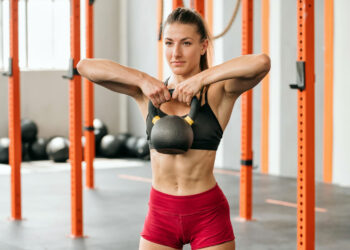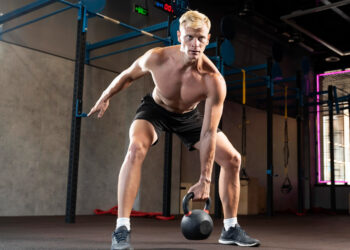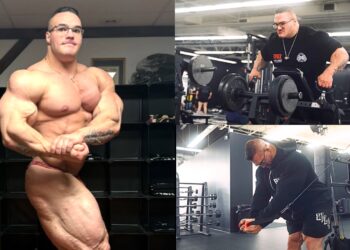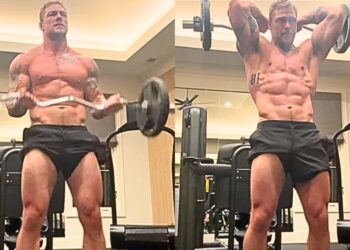Many people believe that you need access to a well-equipped gym to get strong and build muscle. They assume that a lack of equipment will stop them from achieving the body transformation they dream of.
The thing is, your body is actually kind of dumb and finds it hard to differentiate between doing bench presses with a calibrated Olympic barbell in a state-of-the-art gym and doing push-ups on a dusty garage floor.
What your body DOES know are muscle tension and work, and providing you train hard and consistently, your body will adapt to whatever workout you perform. That’s why dumbbell, barbell, machine, freeweight, and resistance band exercises are all similarly effective.
This is good news for home exercisers who, for reasons of budget and space, are often limited to just a couple of pieces of strength training equipment, such as a pair of adjustable dumbbells or a couple of kettlebells.
In this article, we reveal the 15 best upper-body kettlebell exercises and provide you with a couple of workouts to try.
The 15 Best Upper Body Kettlebell Exercises
Don’t let a lack of training equipment stop you from building a muscular and strong physique. Instead, plan your workouts around these upper-body kettlebell exercises!
Level Up Your Fitness: Join our 💪 strong community in Fitness Volt Newsletter. Get daily inspiration, expert-backed workouts, nutrition tips, the latest in strength sports, and the support you need to reach your goals. Subscribe for free!
- Single-arm kettlebell press
- Shoulder-to-shoulder kettlebell press
- Kettlebell halo
- Single-arm kettlebell floor press
- Single-arm decline kettlebell floor press
- Off-set kettlebell push-up
- Kettlebell deficit push-up
- Kettlebell diamond push-up
- Kettlebell single-arm bent-over row
- Kettlebell renegade row
- Kettlebell upright row
- Kettlebell two-handed hammer curl
- Kettlebell hammer curl
- Kettlebell skull crusher
- Kettlebell triceps kickback
1. Single-arm kettlebell press
Target muscles: Deltoids, triceps, core.
The single-arm kettlebell press is one of the best upper-body exercises you can do. This simple move will build your shoulders, upper traps, triceps, and core and contribute to your V-taper. While you can press two kettlebells simultaneously, the single-arm version is arguably more functional, providing a great low-tech but high-effect upper-body workout.
Steps:
- Raise and hold your kettlebell to shoulder height so that it rests against the back of your forearm. Brace your core and pull your shoulders down and back. Tuck your upper arm into your side.
- Stand with your feet between shoulder and hip-width apart, knees slightly bent for balance. Keep your shoulders and hips level.
- Without using your legs for assistance, press the kettlebell up and overhead to arm’s length. Straighten but do not lock your elbow.
- Bend your arm, lower the weight back down, and repeat.
- Swap arms and do the same number of reps on the opposite side.
Tips:
- Grip the handle tightly to stabilize your wrist and increase pushing power.
- Perform this exercise in front of a mirror to ensure your shoulders and hips remain level.
- You can also do this exercise with two kettlebells:
2. Shoulder-to-shoulder kettlebell press
Target muscles: Deltoids, triceps, core.
The shoulder-to-shoulder kettlebell press is a unique deltoid exercise. It’s an excellent movement for anyone who wants to train both deltoids simultaneously but only has access to one kettlebell. The action is very joint-friendly, making this a valuable option for lifters with shoulder pain.
Steps:
- Stand with your feet between shoulder and hip-width apart, knees slightly bent for balance. Brace your core and pull your shoulders down and back.
- Hold your kettlebell in the palm of one hand at shoulder height. Place your other hand on the top, so your forearm is in front of your face.
- Without using your legs for assistance, press the weight over your head and then lower it to your other shoulder. The kettlebell should follow an arc.
- Press the weight back up and over, returning it to the starting position.
- Continue for the desired number of repetitions.
Tips:
- Use lifting chalk or dry your hands on a towel at the start of each set.
- Squeeze your palms against your kettlebell for a more secure grip and increased muscle activation.
- Use a light to medium-weight kettlebell – this exercise is harder than it looks.
3. Kettlebell halo
The kettlebell halo is a classic shoulder exercise that builds strength and mobility in equal measure. Done with a light weight, halos are a great way to warm up your shoulders before heavy lifting. However, done nearer to the end of your workout, it’s an excellent finisher that will give you a tremendous deltoid pump.
Steps:
- Stand with your feet between shoulder and hip-width apart, knees slightly bent for balance. Brace your core and pull your shoulders down and back.
- Hold your kettlebell in front of your chest with the rounded part uppermost using a parallel or neutral grip.
- Circle the kettlebell around your head so it’s inverted when it’s behind you. Lift your elbows as high as possible while keeping the kettlebell at the same height and distance from your head.
- Return the weight to the starting position, and then do your next rep in the opposite direction.
- Continue alternating between clockwise and counterclockwise for the required number of reps.
Tips:
- Perform this exercise slowly and smoothly to avoid hitting your head.
- Keep your torso still and ensure that most of the movement comes from your shoulders, not your lower back.
- Go a goblet squat between halo reps to burn more calories and add a cardiovascular conditioning element to this exercise.
4. Single-arm kettlebell floor press
Target muscles: Pectoralis major, deltoids, triceps, core.
Before the bench press became the world’s favorite chest exercise, the floor press was how most people trained their pecs. This exercise is a very safe and effective way to build upper body pressing power and is especially shoulder-friendly.
Steps:
- Lie on your back with your legs bent and feet flat. Hold your kettlebell above your chest, so your arm is vertical. Use a neutral or palms-facing inward grip. Brace your core and push your shoulders into the ground.
- Bend your elbow and lower the weight down until your triceps touch the floor. Bring your upper arm in close to your side.
- Press the kettlebell back up and repeat.
Tips:
- Grip the kettlebell tightly to stabilize the weight and increase muscle engagement.
- Use your non-working arm to self-spot if necessary.
- You can also do this exercise with two kettlebells:
5. Single-arm decline kettlebell floor press
Target muscles: Pectoralis major, deltoids, triceps, core.
The single-arm kettlebell floor press is a great exercise, but your workouts will soon become boring if that’s all you ever do. Lifting your hips into a bridge position changes the feel of the exercise, increases the range of motion, and engages your glutes and hamstrings, making it a more complete workout.
Steps:
- Lie on your back with your legs bent and feet flat. Hold your kettlebell above your chest, so your arm is vertical. Use a neutral or palms-facing inward grip. Brace your core and push your shoulders into the ground.
- Lift your butt up toward the ceiling, so your hips, knees, hips, and shoulders form a straight line.
- Maintaining the butt-up position, bend your elbow and lower the weight down until your triceps touch the floor. Bring your upper arm in close to your side.
- Press the kettlebell back up and repeat.
Tips:
- Keep your abs braced to prevent your shoulders or hips from twisting.
- Keep your hips up for your entire set or lower them between reps as preferred.
- You can also do this exercise with two kettlebells:
6. Off-set kettlebell push-up
Target muscles: Pectoralis major, deltoids, triceps, core.
Push-ups are one of the best minimalist chest exercises you can do. Using a kettlebell increases your range of motion and also puts a little more weight on one arm, making them even more effective.
Steps:
- Lay your kettlebell on the floor, so it’s resting on its side.
- Adopt the push-up position with one hand resting on the kettlebell and the other on the floor. Brace your core and pull your shoulders down and back.
- Bend your arms and lower your chest down to within an inch of the floor. Get a mild stretch in your chest.
- Push yourself back up and repeat.
- Rest a moment, place your other hand on the kettlebell, and then do your next set.
Tips:
- Ensure you do an even number of sets to train both arms equally.
- Raise your feet to put more weight on your hands, making this exercise more challenging.
- Wear a weighted vest to make this exercise harder.
7. Kettlebell deficit push-up
Target muscles: Pectoralis major, deltoids, triceps, core.
One of the best ways to make push-ups more challenging and better for muscle growth is to increase your range of motion. You can use push-up handles, yoga blocks, weight plates, or, more conveniently, a pair of kettlebells. Using kettlebells means you’ll have to work extra hard to stabilize the weights, which will increase muscle engagement.
Steps:
- Place your kettlebells on the floor so the handles are parallel and the weights are about shoulder-width apart.
- Squat down, grab the handles, and walk your feet out and back into the push-up position.
- Brace your abs and pull your shoulders down and back.
- Bend your arms and lower your chest down between your hands. Get a good stretch in your chest without hyperextending your shoulders.
- Push yourself back up and repeat.
Tips:
- Bend your legs and rest on your knees to make this exercise easier.
- Raise your feet to put more weight on your hands and make this exercise harder.
- Wear a weighted vest to make this exercise more challenging.
8. Kettlebell diamond push-up
Target muscles: Pectoralis major, deltoids, triceps, core.
Diamond push-ups are very effective triceps and chest exercise. However, they can be hard on your wrists and shoulders. Using a kettlebell makes diamond push-ups safer, more comfortable, and more effective. You’ll need to push extra hard to keep your hands on the weight, increasing pec engagement in the process.
Steps:
- Lay your kettlebell on the floor, so it’s resting on its side.
- Adopt the push-up position with both hands resting on the kettlebell. Brace your core and pull your shoulders down and back.
- Bend your arms and lower your chest down to the kettlebell. Keep your upper arms close to your sides.
- Push yourself back up and repeat.
Tips:
- Bend your legs and rest on your knees to make this exercise easier.
- Raise your feet to put more weight on your hands and make this exercise harder.
- Wear a weighted vest to make this exercise more challenging.
9. Kettlebell single-arm bent-over row
Target muscles: Latissimus dorsi, biceps, trapezius, rhomboids, core.
Single-arm bent-over rows are a great way to build and strengthen your upper and lower back. Using one hand and being unsupported means your core also gets a workout. This is an excellent exercise for identifying and fixing left-to-right strength imbalances. However, you probably won’t be able to use as much weight as you would for regular supported bent-over rows.
Steps:
- Stand with your feet about hip-width apart, one kettlebell in your hand. Bend your knees slightly, brace your core, and pull your shoulders down and back.
- Hinge forward from your hips, so your arm hangs straight down from your shoulder. Turn your palm inward. Do not round your lower back.
- Bend your arm and pull the kettlebell up and into your ribs. Keep your elbow close to your side, and do not allow your shoulders or hips to twist.
- Extend your arm and repeat.
- Do the same number of reps on both arms.
Tips:
- Rotate your hand outward to increase lat and upper back engagement.
- Place your free hand on a bench or step for support if required.
- You can also do this exercise with two kettlebells:
10. Kettlebell renegade row
Target muscles: Latissimus dorsi, biceps, trapezius, rhomboids, core.
Back exercises don’t come much more functional or challenging than kettlebell renegade rows. While you will need two kettlebells for this exercise, if you have the necessary equipment, you will be rewarded with an incredible back and core workout.
Steps:
- Place your kettlebells on the floor so the handles are parallel and the weights are about shoulder-width apart.
- Squat down, grab the handles, and walk your feet out and back into the push-up position.
- Brace your abs and pull your shoulders down and back.
- Keeping one arm and your body straight, bend the other elbow and row the weight up and into the side of your abdomen.
- Put the kettlebell back on the floor and then repeat the movement with your other arm.
- Continue alternating arms for the duration of your set.
Tips:
- Bend your legs and rest on your knees to make this exercise easier.
- Alternate renegade rows with deficit push-ups for a complete upper-body workout in minutes:
11. Kettlebell upright row
Target muscles: Trapezius, deltoids, biceps.
Upright rows are a somewhat controversial exercise, and some people love them while others hate them. That’s because upright rows can be hard on the shoulders and may cause joint pain. So, if upright rows bother your shoulders, feel free to skip this exercise. But, if you can do them without pain, upright rows are a great way to build your shoulders and upper traps.
Level Up Your Fitness: Join our 💪 strong community in Fitness Volt Newsletter. Get daily inspiration, expert-backed workouts, nutrition tips, the latest in strength sports, and the support you need to reach your goals. Subscribe for free!
Steps:
- Hold the top of your kettlebell with an overhand grip, thumbs touching. Stand with your arms straight, feet about shoulder-width apart, and knees slightly bent. Brace your core and pull your shoulders down and back.
- Bend your arms and pull the kettlebell up the front of your body. Lead with your elbows. Pull the weight up to just below your chin.
- Lower the weight to arm’s length and repeat.
Tips:
- Pull the weight up to mid-chest height if pulling to your chin bothers your shoulders.
- You can also do this exercise using one arm at a time.
- Combine this exercise with a sumo deadlift to turn it into a full-body movement:
12. Kettlebell two-handed hammer curl
Target muscles: Biceps, brachialis, brachioradialis.
Most kettlebell exercises are compound in nature, meaning they involve multiple muscles and joints working together. However, there are a few exceptions to this rule, and you can train your arms with kettlebells, too. Kettlebell two-handed hammer curls are an excellent biceps and forearm exercise.
Steps:
- Stand with your feet between shoulder and hip-width apart, knees slightly bent for balance. Brace your core and pull your shoulders down and back.
- Using the vertical handles, hold your kettlebell in front of your hips, with your palms facing inward.
- Bend your elbows and curl the weight up to shoulder height. Keep your upper arms close to your sides.
- Slowly lower the kettlebell back to arm’s length and repeat.
Tips:
- Grip the handles tightly to maximize biceps and forearm engagement.
- Lean forward slightly to change the strength curve of this exercise.
- Pause at the top of each rep for 2-3 seconds to maximize biceps and forearm recruitment.
13. Kettlebell hammer curl
Target muscles: Biceps, brachialis, brachioradialis.
This unusual exercise changes the lever length as you raise the weights to give your biceps and forearms a unique workout. You’ll only need light kettlebells for this exercise, as it’s much more challenging than it looks!
Steps:
- Hold your kettlebells down by your sides. Stand with your feet between shoulder and hip-width apart, knees slightly bent for balance. Brace your core and pull your shoulders down and back.
- Bend your arms and curl the kettlebells forward and up until your forearms are slightly above parallel to the ground. Pause for 1-2 seconds.
- Slowly lower the weights and repeat.
Tips:
- You can do this exercise seated instead of standing.
- Use an alternating arm action if preferred.
- Do this exercise with a single kettlebell if that’s all you have available.
14. Kettlebell skull crusher
Target muscles: Triceps.
Skull crushers are so-called because they involve lowering a weight very close to your head. Needless to say, this exercise has this name for a reason, so you should take extra care when performing it. That said, the aptly-named skull crusher is a very effective triceps exercise, even if it has the potential to maim you!
Steps:
- Place a kettlebell on the floor and then lie on your back, so it’s just above your head. Then, reach up and back to grab the vertical handles, so your thumbs are pointing downward.
- Pull your shoulders down and back and your upper arms in toward your head.
- Extend your elbows and press the kettlebell up to the ceiling. Ensure most of the movement comes from your elbows and not your shoulders.
- Lower the kettlebell back down to the floor and repeat.
Tips:
- You can also do this exercise on a bench.
- Experiment with the angle of your upper arms to see where you feel the strongest triceps contraction.
- You can also do this exercise with a kettlebell in each hand, albeit using light weights.
15. Kettlebell triceps kickback
Target muscles: Triceps.
Triceps kickbacks are one of those exercises that people love to hate. They hate how hard it is, even when using light weights, but love how intensely their triceps contract. This variation changes the length of the lever to hit your triceps even harder as you extend your arms. You’re REALLY going to love/hate this one!
Steps:
- Hold a kettlebell in each hand and stand with your feet together. Pull your shoulders down and back, and brace your abs. Bend your knees slightly.
- Hinging from the hips, bend over until your upper body is just above parallel to the floor.
- Pull your upper arms into your sides and bend your elbows to 90 degrees.
- Extend your arms and push the kettlebells back toward your hips. Pause mid-rep for 1-3 seconds.
- Bend your arms, return to the 90-degree position, and repeat.
Tips:
- You can also do this exercise using one arm/kettlebell at a time.
- Place your non-working arm on a bench to support your lower back.
- Superset this exercise with kettlebell diamond push-ups for maximal triceps fatigue in minimal time.
Three Upper Body Kettlebell Workouts to Try
Here are THREE kettlebell-only upper body workouts to try!
Workout 1 – Chest and Back
| # | Exercise | Sets | Reps | Recovery |
| 1 | Single-arm kettlebell floor press | 4 | 6-8 | 2 minutes |
| 2 | Kettlebell single-arm bent-over row | 4 | 6-8 | 2 minutes |
| 3 | Off-set kettlebell push-up | 3 | 10-12 | 90 seconds |
| 4 | Kettlebell renegade row | 3 | 10-12 | 90 seconds |
| 5 | Single-arm decline kettlebell floor press | 2 | 15-20 | 60 seconds |
| 6 | Kettlebell upright row | 2 | 15-20 | 60 seconds |
Workout 2 – Shoulders and Arms
| # | Exercise | Sets | Reps | Recovery |
| 1 | Shoulder-to-shoulder kettlebell press | 3 | 8-12 | 90 seconds |
| 2 | Kettlebell halo | 3 | 8-12 | 90 seconds |
| 3 | Kettlebell upright row | 3 | 8-12 | 90 seconds |
| 4 | Kettlebell diamond push-up | 3 | AMRAP | 60 seconds |
| 5 | Kettlebell two-handed hammer curl | 3 | 12-15 | 60 seconds |
AMRAP = As Many Reps as Possible
Workout 3 – Upper Body
| # | Exercise | Sets | Reps | Recovery |
| 1 | Single-arm decline kettlebell floor press | 4 | 8-12 | 90 seconds |
| 2 | Kettlebell single-arm bent-over row | 3 | 8-12 | 90 seconds |
| 3 | Single-arm kettlebell press | 4 | 8-12 | 90 seconds |
| 4 | Kettlebell renegade row | 3 | 8-12 | 90 seconds |
| 5 | Kettlebell triceps kickback | 2 | 12-15 | 60 seconds |
| 6 | Kettlebell hammer curl | 2 | 12-15 | 60 seconds |
FAQs
Do you have a question about these kettlebell upper body exercises? That’s okay because we’ve got the answers!
1. How many reps should I do per exercise?
Kettlebells tend to come in fixed weights, e.g., 25 pounds, 40 pounds, etc. As such, your rep range will depend on the kettlebells to which you have access. Home exercisers tend to have one medium and one heavy weight kettlebell. In contrast, some gyms have a much wider range of weights available.
So, do as many reps as possible in good form and within 2-3 reps of failure. This might be six or sixteen reps depending on the exercise, strength, and weights available. Strive to do more reps per set as you get stronger.
2. Are kettlebells good for building muscle?
Kettlebells are excellent for building muscle, but then so too are barbells and dumbbells. Contrary to what you may have heard, kettlebells are no better (or worse) than other types of weight and are just another tool we have for strength training.
In some cases, barbells are better, e.g., for deadlifts and squats. In others, dumbbells work best, e.g., for flies and presses. Ultimately, your body has a hard time differentiating between types of training equipment. So long as you work hard and consistently, you should achieve the desired results.
So, yes, kettlebells are good for building muscle, but they’re only one of the many things we can use to get bigger and stronger.
3. What is a pood?
A pood is a Russian unit of measure often used with kettlebells. That’s because kettlebell lifting is an official sport in Russia, and, as such, the weight of some kettlebells is expressed in poods and fractions of poods.
One pood is equal to 16.38 kilograms or 36.11 pounds. However, most kettlebell manufacturers round this down to 35 pounds per pood. This makes calculating the weight of a kettlebell more straightforward.
4. I want to buy a kettlebell – what weight should I buy?
Kettlebells are available in the range of fixed weights, from around 6kg (12 pounds) to 35 kg (75 pounds). There are also super heavyweight kettlebells available that weigh close to 100 pounds.
Most male beginners will be happy with a kettlebell weighing 12-24kg, while the ideal weight for women is 8-16kg.
That said, it’s worth buying two kettlebells (a medium and a heavy one), so you can do upper and lower body exercises. For example, men might benefit from having a 16kg and a 24kg kettlebell. The 16 is excellent for presses and rows, while the 24 is perfect for swings and squats.
Alternatively, you can buy an adjustable kettlebell, but these tend to be expensive and not as hardwearing as a fixed-weight kettlebell.
5. Can you give me a quick lower-body kettlebell workout to complement my lower-body training?
Sure can! Grab one heavy kettlebell and do this superset:
- Kettlebell goblet squats – 15-20 reps
- Rest 15 seconds
- Kettlebell swings – 15-20 reps
- Rest 1-2 minutes and then repeat three more times
This superset will smoke your quadriceps, hamstrings, and glutes in 15 minutes or less. Plus, you’ll get a tremendous fat-burning cardio workout, too.
More on Kettlebells:
- Kettlebell Exercises For Hypertrophy, Strength and Function
- The Ultimate Guide to Buying Kettlebell Weights
- Kettlebell Arm Workout For Building Size and Conditioning
- One Kettlebell and Bodyweight Full-Body Workout
- The One Kettlebell Workout
Closing Thoughts
Kettlebells are versatile training tools that can be used singularly or in pairs. They’ve ideal for home gyms because you can use them for various exercises and train your entire body with just 1-2 weights.
Are kettlebells better than dumbbells or barbells? Probably not.
After all, your body cannot differentiate between presses with kettlebells or presses with a barbell or dumbbells. But, if you enjoy using kettlebells and train with them regularly, you can use them to build muscle, get stronger, and burn fat in the comfort of your own home.


